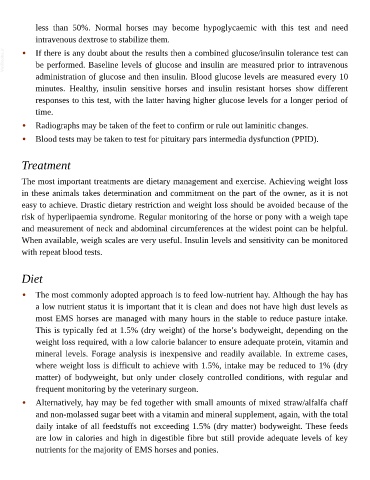Page 973 - The Veterinary Care of the Horse
P. 973
less than 50%. Normal horses may become hypoglycaemic with this test and need
intravenous dextrose to stabilize them.
VetBooks.ir • If there is any doubt about the results then a combined glucose/insulin tolerance test can
be performed. Baseline levels of glucose and insulin are measured prior to intravenous
administration of glucose and then insulin. Blood glucose levels are measured every 10
minutes. Healthy, insulin sensitive horses and insulin resistant horses show different
responses to this test, with the latter having higher glucose levels for a longer period of
time.
• Radiographs may be taken of the feet to confirm or rule out laminitic changes.
• Blood tests may be taken to test for pituitary pars intermedia dysfunction (PPID).
Treatment
The most important treatments are dietary management and exercise. Achieving weight loss
in these animals takes determination and commitment on the part of the owner, as it is not
easy to achieve. Drastic dietary restriction and weight loss should be avoided because of the
risk of hyperlipaemia syndrome. Regular monitoring of the horse or pony with a weigh tape
and measurement of neck and abdominal circumferences at the widest point can be helpful.
When available, weigh scales are very useful. Insulin levels and sensitivity can be monitored
with repeat blood tests.
Diet
• The most commonly adopted approach is to feed low-nutrient hay. Although the hay has
a low nutrient status it is important that it is clean and does not have high dust levels as
most EMS horses are managed with many hours in the stable to reduce pasture intake.
This is typically fed at 1.5% (dry weight) of the horse’s bodyweight, depending on the
weight loss required, with a low calorie balancer to ensure adequate protein, vitamin and
mineral levels. Forage analysis is inexpensive and readily available. In extreme cases,
where weight loss is difficult to achieve with 1.5%, intake may be reduced to 1% (dry
matter) of bodyweight, but only under closely controlled conditions, with regular and
frequent monitoring by the veterinary surgeon.
• Alternatively, hay may be fed together with small amounts of mixed straw/alfalfa chaff
and non-molassed sugar beet with a vitamin and mineral supplement, again, with the total
daily intake of all feedstuffs not exceeding 1.5% (dry matter) bodyweight. These feeds
are low in calories and high in digestible fibre but still provide adequate levels of key
nutrients for the majority of EMS horses and ponies.

